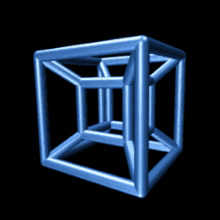Zero-dimensional space
In mathematics, a zero-dimensional topological space (or nildimensional) is a topological space that has dimension zero with respect to one of several inequivalent notions of assigning a dimension to a given topological space.[1][2] A graphical illustration of a nildimensional space is a point.[3]
| Geometry | ||||||||||
|---|---|---|---|---|---|---|---|---|---|---|
 | ||||||||||
|
|
||||||||||
| Geometers | ||||||||||
|
by name
|
||||||||||
|
by period
|
||||||||||
Definition
Specifically:
- A topological space is zero-dimensional with respect to the Lebesgue covering dimension if every open cover of the space has a refinement which is a cover by disjoint open sets.
- A topological space is zero-dimensional with respect to the finite-to-finite covering dimension if every finite open cover of the space has a refinement that is a finite open cover such that any point in the space is contained in exactly one open set of this refinement.
- A topological space is zero-dimensional with respect to the small inductive dimension if it has a base consisting of clopen sets.
The three notions above agree for separable, metrisable spaces.
Properties of spaces with small inductive dimension zero
- A zero-dimensional Hausdorff space is necessarily totally disconnected, but the converse fails. However, a locally compact Hausdorff space is zero-dimensional if and only if it is totally disconnected. (See (Arhangel'skii 2008, Proposition 3.1.7, p.136) for the non-trivial direction.)
- Zero-dimensional Polish spaces are a particularly convenient setting for descriptive set theory. Examples of such spaces include the Cantor space and Baire space.
- Hausdorff zero-dimensional spaces are precisely the subspaces of topological powers where is given the discrete topology. Such a space is sometimes called a Cantor cube. If I is countably infinite, is the Cantor space.
Hypersphere
The zero-dimensional hypersphere is a point.
Notes
- Arhangel'skii, Alexander; Tkachenko, Mikhail (2008), Topological Groups and Related Structures, Atlantis Studies in Mathematics, Vol. 1, Atlantis Press, ISBN 978-90-78677-06-2
- Engelking, Ryszard (1977). General Topology. PWN, Warsaw.
- Willard, Stephen (2004). General Topology. Dover Publications. ISBN 0-486-43479-6.
gollark: I think there are even printed copies somewhere ingame.
gollark: I'm sure it's been backuped in a lot of places now.
gollark: I can't "delete potatos". How would that even work?
gollark: ...
gollark: You can set the `potatOS.disable_ezcopy` setting to `true` now to stop it copying.
References
- "zero dimensional". planetmath.org. Retrieved 2015-06-06.
- Hazewinkel, Michiel (1989). Encyclopaedia of Mathematics, Volume 3. Kluwer Academic Publishers. p. 190. ISBN 9789400959941.
- Wolcott, Luke; McTernan, Elizabeth (2012). "Imagining Negative-Dimensional Space" (PDF). In Bosch, Robert; McKenna, Douglas; Sarhangi, Reza (eds.). Proceedings of Bridges 2012: Mathematics, Music, Art, Architecture, Culture. Phoenix, Arizona, USA: Tessellations Publishing. pp. 637–642. ISBN 978-1-938664-00-7. ISSN 1099-6702. Retrieved 10 July 2015.
This article is issued from Wikipedia. The text is licensed under Creative Commons - Attribution - Sharealike. Additional terms may apply for the media files.
